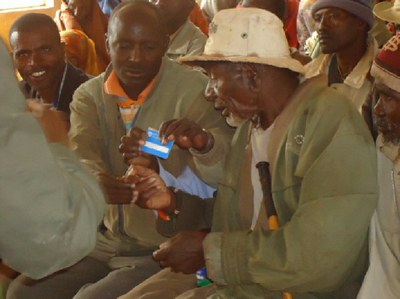East Africa Famine: Deadly competition for survival

Joseph Kajwang, from SOS Children's Villages Kenya, tells us how, in the dried-out region of Marsabit, SOS Children is battling the harsh conditions to reach remote villages.
"From Kenya’s capital Nairobi, Marsabit can be reached either by air or by land. By road, the trip takes up to a day and is very risky, as convoys are sometimes ambushed. Travelling by air is quicker and also impressively shows the huge distances that any supply transport must travel as the tiny plane crosses endless desert landscapes with virtually no human settlements.
We approach a town on high ground, with a parched forest and surrounded by what was once farmland, now bone dry and desolate. On stepping out of the plane, I am instantly enveloped in wind and dust.
The once-cool climate is a thing of the past
Marsabit was once a thriving agricultural region. Community elders fondly recall the cool and rainy climate that allowed them to cultivate maize, wheat and even oranges, bananas and mangoes, now a thing of the past. The streams, springs and even Lake Paradise, once a popular destination for tourists, have dried out. It last rained in April 2007 - for just two weeks.
Humans and wildlife have entered a deadly competition
Since then, humans and wildlife have entered a fierce and sometimes deadly competition for survival that is hard to imagine for people in countries where sufficient water for all is a given. We pass baboons on the side of the road, scavenging the dusty landscape. Baboons, chimpanzees and even elephants, who normally avoid humans, have been known to raid villages for food and water. The elephants are a deadly threat, and I am told that one man was killed by elephants just last year as he was fetching water from the last remaining water hole in the area.
SOS Children is a leading partner
We drive to our makeshift office at a small hotel. SOS Children wasn’t active in the Marsabit region before the current food crisis. In early August 2011, SOS Children joined a steering group made up of NGO’s and government bodies that ensures efficient help for the most desperate. Since then, SOS Children’s Villages Kenya has become a leading member of the group.
Without water, everything is meaningless
Any relief effort that does not include the provision of clean water is meaningless to the starving communities. SOS Children helps comprehensively, bringing water first and foremost, but also food and health care.
Electronic food vouchers
And yet, the logistical problems and high cost of transporting supplies to the remote villages demand more efficient solutions. SOS Children has been working hard, together with community elders, authorities and shop owners, to implement a system of electronic food vouchers that will allow villagers to purchase supplies straight from the shops in their areas, significantly reducing the extreme cost of transportation. We have so far implemented this in four different villages. We have had to explain to the communities how the system works, the money that each holds and how they will access the shops and the kind of food stuff that they are allowed to get from the shops.
Children return to school to survive
By distributing thousands of meals in the schools of the most affected communities, SOS Children has created a doubly beneficial effect: Many parents were previously forced to take their children out of school and send them to forage for food and water. Now, they are sending them back to school, where they are not only fed but also continue their education, which will help communities to develop in the years to come.
Many are likely to die
For now, the villages seem empty, as the men have migrated north with their little remaining livestock in search of better pastures. Many – both cattle and men - are likely to die in the process, further robbing the villages of their livelihoods and condemning them to perpetual poverty."
Listen to Joseph Kajwang talking about SOS Children's emergency programmes in Kenya:
SOS Children's Emergency Relief in Kenya
Northern Kenya
has been one of the countries most affected by the East African drought. Rising
food prices have pushed many families into poverty, with the price of
maize having risen by up to 150%. In the Marsabit
District, water is scarce and medical services
almost non-existent. SOS Children already runs a Family Strengthening Programme (FSP) in Marsabit, so were
well positioned to respond urgently to the humanitarian crisis.
We are supporting the three vulnerable communities we already work with in Marsabit, as well as two additional local villages, which are all together home to over 10,000 people. Working in partnership with other humanitarian agencies including the Red Cross, we are particularly helping malnourished children, breast-feeding mothers and the elderly.
We are providing relief items including food vouchers and cash; have launched a school feeding programme; and are providing clean drinking water and vaccinations to the most vulnerable.
How you can help
You can make a one-off donation directly to our Emergency Relief Programme, or take out a child sponsorship to help us to focus on the long-term welfare of children who have no one to care for them as a result of the famine.

 Return to Schools Wikipedia Home page…
Return to Schools Wikipedia Home page…
